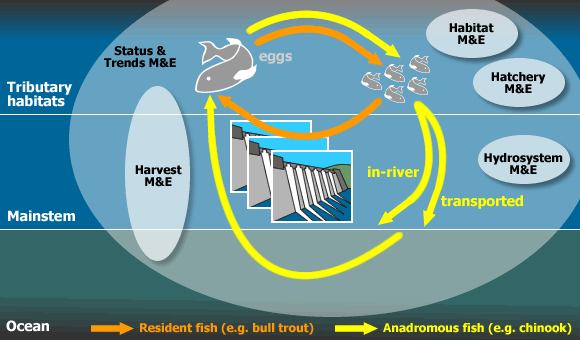CSMEP Improved Monitoring and Evaluation Designs
CSMEP is attempting to develop general design templates for monitoring the status and trends of fish populations and the effectiveness of habitat, harvest, hatchery and hydrosystem recovery actions within the Columbia River Basin. This requires a synergy between Policy Translation subgroups that can clarify the existing policy issues and Monitoring Design Subgroups that have the technical expertise to develop generalized monitoring designs.
For this task CSMEP is using the EPA Data Quality Objectives (DQO) process to rigorously define the connections between policy decisions and the monitoring designs that provide the input for these decisions. The DQO process is a 7-step template that helps 'translate' existing policies into the spatial and temporal bounds and quantitative parameters crucial for developing monitoring designs.
CSMEP's five policy interpretation and design workgroups

CSMEP is implementing systematic processes for developing and evaluating integrated designs that address key anadromous and resident fish management questions. Alternative designs have been developed using the EPA's Data Quality Objectives process, which begins with decisions and moves systematically to designs. CSMEP is also considering sampling approaches such as EMAP, which facilitate data aggregation to multiple spatial scales, and data sharing by multiple agencies. The designs will be evaluated using both quantitative and qualitative decision analysis approaches.
Available resources to fund studies are limited, and research, monitoring and evaluation (RME) priorities vary regionally. Therefore, CSMEP is developing a range of integrated designs with different costs and levels of reliability. CSMEP is first applying this approach to the Snake River Basin (spring/summer and fall Chinook ESUs), with a planned expansion to other parts of the Columbia basin in FY07-09. These designs will be systematically evaluated against a number of criteria (e.g. cost, precision, accuracy, and ability to answer status & trend and action effectiveness questions). The intent is to narrow the set of alternative designs down to just a few integrated designs which provide a high level of certainty with respect to the highest priority questions in a pilot subbasin, while attempting to address other management questions at a lower level of certainty. Since limiting factors and actions vary across subbasins, designs for action effectiveness RME will also vary, though within a consistent framework for assessing the status and trend of fish populations. Integrating multiple objectives into the study design up front is expected to be more cost effective than the more common process of mining data for ancillary benefits after the study is completed. For example, CSMEP has developed methods for maximizing the potential to obtain useful information from marked groups of fish, to serve multiple RME objectives (i.e. survival estimates for status and trend monitoring, action effectiveness evaluations at varying scales for habitat, hatchery, harvest and hydro questions.).